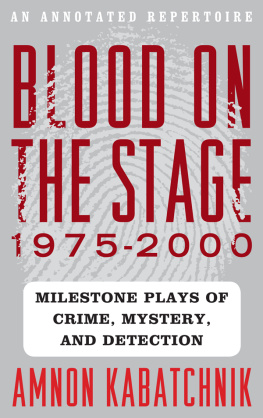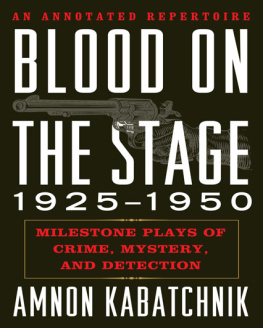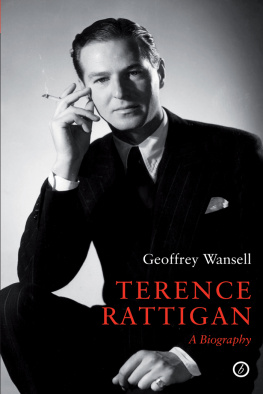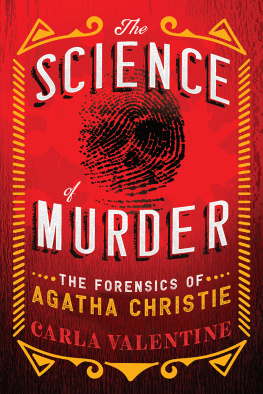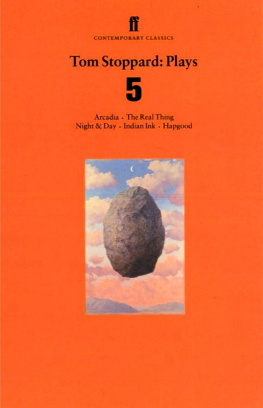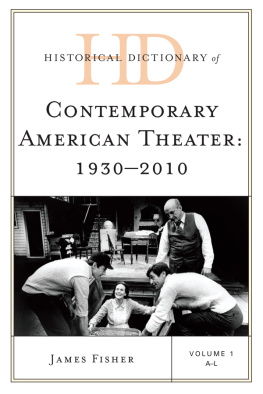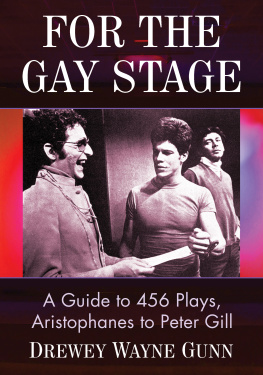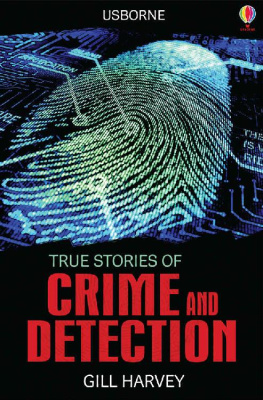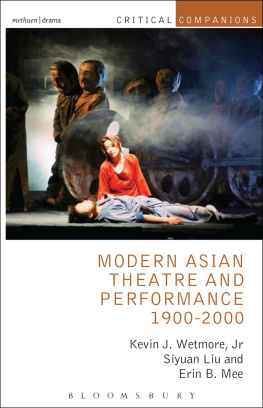Blood on the Stage, 19752000
Milestone Plays of Crime, Mystery, and Detection: An Annotated Repertoire
Amnon Kabatchnik

The Scarecrow Press, Inc.
Lanham Toronto Plymouth, UK
2012
Published by Scarecrow Press, Inc.
A wholly owned subsidiary of The Rowman & Littlefield Publishing Group, Inc.
4501 Forbes Boulevard, Suite 200, Lanham, Maryland 20706
www.rowman.com
10 Thornbury Road, Plymouth PL6 7PP, United Kingdom
Copyright 2012 by Amnon Kabatchnik
All rights reserved . No part of this book may be reproduced in any form or by any electronic or mechanical means, including information storage and retrieval systems, without written permission from the publisher, except by a reviewer who may quote passages in a review.
British Library Cataloguing in Publication Information Available
Library of Congress Cataloging-in-Publication Data
Kabatchnik, Amnon, 1929
Blood on the stage, 19752000 : milestone plays of crime, mystery, and detection: an annotated repertoire / Amnon Kabatchnik.
p. cm.
Includes bibliographical references and index.
ISBN 978-0-8108-8354-3 (cloth : alk. paper) ISBN 978-0-8108-8355-0 (ebook)
1. Detective and mystery playsHistory and criticism. 2. Detective and mystery playsStories, plots, etc. I. Title.
PN1952.K36 2012
809.2'527dc23 2012020471
The paper used in this publication meets the minimum requirements of American National Standard for Information SciencesPermanence of Paper for Printed Library Materials, ANSI/NISO Z39.48-1992.
Printed in the United States of America

To the memory of my beloved parents,
Hanita and Alexander
Acknowledgments
I would like to express my gratitude to a number of friends and scholars who were extremely helpful in various ways and made this project possible.
To Marv Lachman who, several decades ago, invited me to a series of literary parties at his Bronx apartment where he, Bob Aucott, Jon Breen, Lianne Carlin, Pat Erhardt, Allen J. Hubin, Francis Nevins Jr., Otto Penzler, Charles Shibuk, and Chris Steinbrunner suggested that I not only read and collect detective literature but also study its sources, history, and trends. These gifted ladies and gentlemen have since edited journals, penned books, and launched a wave of scholarship in the field. Their influence on the development of this resource book is highly appreciated.
I am greatly indebted to the late publisher Ted Dikty, who planted the seed of Blood on the Stage in my mind, and to Professor Robert Reginald of California State University at San Bernardino for encouraging me to develop an annotated checklist of suspense plays into a book-length endeavor.
A special note of thanks to Bryan Reddick, academic dean of Elmira College, and professors Jerome Whalen and Leonard Criminale, who offered valuable suggestions regarding classic crime plays.
In my pursuit of old, out-of-print manuscripts and yesteryears newspapers and magazines, I traveled to a number of libraries near and far. My gratitude in particular to the librarians of the Steele Memorial Library of Elmira, New York (notably Owen Frank); the Corning, New York, Public Library; the Olin and Uris Libraries at Cornell University in Ithaca, New York; the New York Public Library of the Performing Arts at Lincoln Center, Manhattan (especially Rod Bladel, Christopher Frith, Christine Karatnytsky, Jeremy McGraw, curator Karen Nickeson, and the three little witches of the photocopy room). Thanks also to Howard Prouty, acquisition archivist at the Center for Motion Picture Study, Beverly Hills, California, and Shimon Lev-Ari, director of the Israeli Documentation Center for the Performing Arts in Tel-Aviv, Israel.
My appreciation goes to past and present staffers of the national office of the Mystery Writers of America in New York City; Eleanor Bader of Brooklyn; Alexa Kelly, Brian Richardson, Andrew Charity, and Alvin and Myra Chanin of Manhattan; George Koch of Queens; Michele Slung of Woodstock, New York; Nancy McCaig of Corning, New York; Lindsay Bajo of San Diego, California; Helga Schier of Santa Monica, California; Lauren Holingsworth of Culver City, California; Bill Waters of Burbank, California; Diana James, publicist, of Pasadena, California; and Regina Miller of the Geffen Theatre, Westwood, California.
Finally, salutation to Peter E. Blau of Washington, D.C., and Andrew Joffe of New York City for their input on Sherlock Holmes and the collecting of Sherlockiana.
Introduction
The first stage crime was committed in ancient Greece. The amphitheatres of Athens were awash in blood. In one of the earliest plays on record, Prometheus Bound (479 BC), the upstart playwright Aeschylus had the gumption to paint Zeus, the king of Olympus, as a mass murderer. To protect his turf, Zeus utilizes his instrument of death, a bolt of lightning, to dispatch the rabble-rouser Prometheus and his loyal nymphs to Hades, because he has stolen fire from the gods and given it to man.
Aeschylus continued to center his plots on treachery and homicide. In The Danaid Tetralogy (463 BC), the fifty daughters of Daneus attempt to flee Egypt to avoid marriage with their cousins. When their escape is foiled, the daughters murder the bridegrooms on the wedding night, thus keeping their virginity and avoiding incestuous relationships. The Oresteia (458 BC), Aeschyluss masterpiece, depicts a succession of crimes and their retribution in the House of Atreus. Clytemnestra, Queen of Argos, is furious at her husband, Agamemnon, leader of the Greek forces in the Trojan War, for bringing the Trojan princess Cassandra into the palace as a slave. The jealous Clytemnestra murders Cassandra, and then throws a robe, like a fish net, around Agamemnon, strikes him three times with an axe, and rejoices as his blood spurts. A feud inherited from generation to generation culminates in the revenge murder of Clytemnestra by her son, Orestes, and his sister, Electra. Orestes also attacks Clytemnestras lover, Aegisthus, and slashes him with his sword. The bloody events lead to an early stage trial: the goddess Athena assembles a jury of twelve Athenian citizens. Their vote is a tie and Orestes is acquitted.
The playwright Sophocles was not far behind in matters of intrigue and suspense. The title character of Ajax (c. 444 BC) loses a debate with Odysseus over who should inherit the recently deceased Achilless armor. Incensed, Ajax plans to kill Agamemnon and Menelaus for assigning the armor to Odysseus. However, the goddess Athena drives Ajax temporarily insane and he instead slaughters cattle and sheep that the Greeks had captured in raids. In Oedipus Rex (c. 430 BC), Sophocles penned the first play to recount the step-by-step investigation of a murder through the interrogation of witnesses. Ironically, the first detective was also the unwitting murderer.
The third great Greek tragedian, Euripides, created the anti-heroine Medea (431 BC), a princess scorned; her jealousy and wrath led her into the compulsive killings of a rival, with a robe smeared with poison, and her own two children, leaving their father, Jason, in hopeless despair. In Hecuba (425 BC), the MacGuffin that causes a series of murders is a bag of gold. The god Dionysus manipulates the women of Thebes to tear their king apart with their bare hands in The Bacchae (405 BC).
On a lighter note, Aristophanes throws satirical darts at corrupt judges in The Knights (424 BC) and ridicules the trial courts in The Wasps (422 BC).
The Roman man-of-letters Seneca incorporated many motifs of Greek mythology into his plays. However, while the Greek dramatists were mostly concerned with the relationship of man and god, Seneca emphasized the human heros merits and faults, pangs of conscience, and final resolution to accept his appointed place in the universe. Still, Senecas plays contain Grand Guignol elements: in Medea (first century AD), the blood-curdling events caused by the vengeful title character are pictured graphically. She instructs her children to deliver to Jasons new bride a robe and a necklace cursed with witchcraft powers. Upon donning the robe, flames engulf the princess and she burns to death. Medea then stabs one of her sons on the roof of the palace. Horrified, Jason watches from the courtyard as Medea stabs her other son and throws both bodies down to him. With an aura of exaltation, Medea flies away in her dragon-drawn chariot. In Senecas Thystes (first century AD), the brothers Thystes and Atreus are to share the throne of their late father. However, Thystes seduces Atreuss wife, steals the Golden Lamb, a symbol of sovereignty, and usurps the throne. Atreus wins back the kingdom in battle, but still nurtures revenge. He captures his nephews and sacrifices them on the altar, chopping their bodies into pieces. All but their heads become part of a banquet menu. The last course is hidden beneath the cover of a silver platter. After Thystes has eaten his meal, the heads of his two sons are revealed and presented to him. When the mourning father requests a proper burial for his sons, Atreus informs him that he has just eaten them. Now Thystes starts planning his payback, illustrating Senecas theme that crime perpetuates crime.

